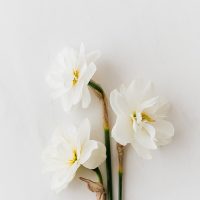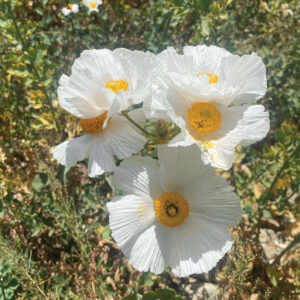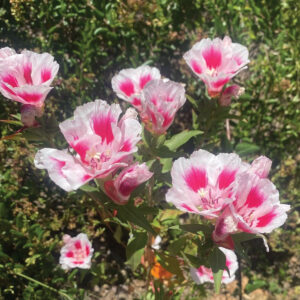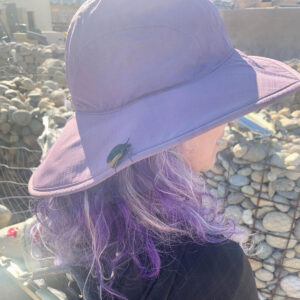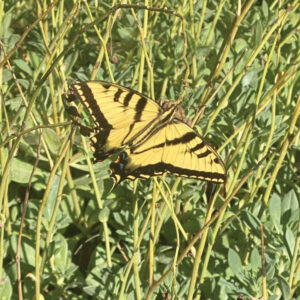Here is another edition of How Not To Landscape Your Yard.
I love taking walks, I go in the morning and then again in the evening – my pups and I sometimes go hiking, but with the heat we mostly stay nearby. Aside from the stress relief, the lovely exercise, and the companionship we are also treated to endless examples of How Not To Landscape your yard.
I thought I’d share a few How Not To Landscape You Yard photos, taken on just a couple of walks. Please take this for what it is my opinions and hopefully you can either chuckle along with me, or learn something. Either would make me happy. If I have inadvertently photographed your yard, rest assured I don’t know it is you and of course would never reveal any names.
I wanted to start out with this horribly pruned Olive tree, I’ll call it “Chopped Olives”. Can you even tell that it is an olive tree? I was flabbergast when I happened upon this, and guess what? I found two more on another street. Just. Like. This. Please, please, please spend your money on a licensed arborist for your tree trimming. The person that did this can NOT possibly have an arborist license, I wonder if they should even be allowed to have a license for their dog! How can this tree photosynthesize without it’s leaves? It is the middle of summer, how can it NOT get sunburnt?
Why have a tree if you are going to attempt to murder it? Sheesh. I also started with this one because I actually got yelled at taking this photograph. The neighbor across the street though that my 9 lb Yorkie and I were likely casing the joint, so she made sure that I knew I was not welcome. I tried to explain to her what I was doing, she didn’t believe me. Not the first time this has happened to me. I guess I’m just a scary person.
This one got some great responses on Facebook – comments like Nom, Nom, Nom, Get in my belly! and looks like Little Shop of Horrors are among my favorites. This shows what I think to be the most common mistakes made by first time homeowners and Landscape Janitors alike. Not reading the plant tag.
If the plant tag says it will get to be 5′ by 5′ why would you put it into a 3′ planter bed or better yet, that 18″ between your pool and the wall? Aside from try to make better design choices when creating your landscape – bigger beds. You can actually make an inherited tiny planting area look nicer and more natural if you just pay attention to how big (especially wide) the plants actually get. If the plant doesn’t have a plant tag, don’t buy it! You can also look plants up on the internet or even in a book for example, The Sunset Western Garden Book. Make sure that you know exactly which plant it is, and the cultivar – that makes a big difference.
This is another case of the above. I call this “Box of Embers” it is actually Euphorbia tirucalli ‘Sticks on Fire’ which gets to be 15′ tall and 10′ wide – it is a GORGEOUS plant. It is not, however a plant that should be pruned into a hedge. Also, look at those arches, why the heck couldn’t the pruner let it grow into the arches and just prune for width at the bottom? If these were pruned on a more regular basis by someone with half a clue, it might actually look nice there! Look at this beautiful branching that could have been highlighted.
(This not the same plant, it is another specimen that has been allowed to actually grow properly)
Here is another current pet peeve of mine. Gravel. I like using gravel within a landscape, in a small area with PLANTS included. I know these people probably just thought about saving water – they thought they were doing the right thing but… too much of a good thing is BAD. If we take out all the plant material and add hot reflective surfaces, we are going to add to our drought problems. We don’t need to raise the temperature, we don’t want to replace good carbon dioxide reducing plant materials with non-living heat producing elements. A nice balance of low or even medium water plant material, including adding trees and some permeable paving materials is just what the doctor ordered when it comes to helping with our drought.
This planter bed could have had a line of bubblers installed with even three or five nice plants added. This landcape could then be helping our environment AND would have reduced water from that thirsty lawn. A few lavender stoechas or verbena de la Mina would bring pollinators to the neighborhood, fragrance, and life! You can still use gravel if you want, but why not some mulch instead?
Okay, I’ll get off my soapbox now, it’s been fun – but again too much of a good thing…
If you want to learn a little more about things you can do to help in the drought, take a look at last week’s post. Are you ready to change your yard but don’t know what to do? Give me a call at 661-917-3521 or visit my website and contact me there.








